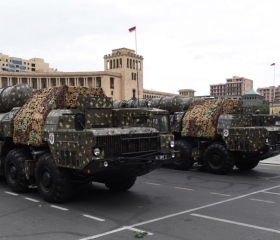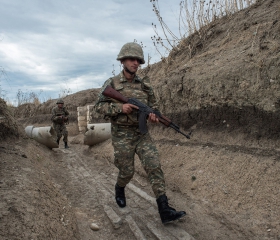Like all other post-Soviet countries in the Commonwealth of Independent States, Armenia celebrated its 25th anniversary of independence in 2016, which is a fitting occasion to draw lessons from the first quarter of a century’s experience, and to look to the future — after lengthy Caucasian toasts have all been raised and drained.
This essay will attempt to outline a future, based on monitoring and a critical understanding of the current trends and track record of the past few years in and around Armenia. As it commonly happens, the course of development in the next few years will depend on a number of internal and external factors, and none of those are constant variables, neither can they be assessed and predicted with mathematical accuracy.
Thomas Jefferson advocated for a fundamental reconsideration of prevailing institutions once in every generation [1]. Along these lines, the next two to three years in Armenia will be marked by transforming the domestic political landscape — for two major reasons, formal and informal. First, the generation of those who earned independence and brought victory in the 1992-94 war will not be around forever. Already in 2013 Armenia’s first President Levon Ter-Petrosyan, now 71, cited age and health issues for not running in the presidential race. No doubt, the influence of the founding fathers on decision-making will continue to have a major impact, yet pending institutional changes will inevitably tailor new circles of influence across the political spectrum.
Secondly, Armenia is scheduled to transform into a parliamentary republic following Constitutional Amendments adopted following a 2015 nationwide referendum, and therefore the forthcoming parliamentary elections of April 2017 (more importantly, the campaign) will mark a tipping point for Armenian political elites to adjust to new rules of the game. Beyond holding these elections in a free, fair, and transparent manner, crucial for ensuring continued support and uninterrupted cooperation with Brussels, Washington and international financial organisations, the future of the Armenian political system will be determined by the alliances and blocs formed in the run-up to the elections, and their endurance in the new parliament. The new Electoral Code — adopted in a rare consensus among the ruling and main opposition parties in Fall of 2016 (even branded as “historic”) — created an environment where mainstream political groupings spoke favorably of the pre-electoral environment.
Minor league political parties are already speaking in favor of forming pre-election coalitions, including some mulling over mergers. It is highly possible to observe the consolidation of parties across the political landscape, and, given the design offered in the new Electoral Code, the emergence of a two-and-a-half strong party system before the 2022 parliamentary elections. The lessons of the failures in some post-Communist parliamentary republics suggest that the sustainability of the system of governance correlates with that of the party system.
The amended Constitution will fully enter into force following the Presidential elections in February 2018. At first sight, nothing more but the transition of executive power from the President to the Prime Minister will take place; but in fact the transition will bring crucial changes as a result of a new institutional design with a more decentralized system of governance, populated by many political parties and interest groups, and a reformed and more robust National Security Council with, possibly, decision-making powers.
Armenia has a dynamic and highly emotional society with a high internet penetration rate, uncensored internet content (‘Free’ status in Freedom of the Net index by Freedom House, 2015), still climbing numbers of social media users and activism, who can boast of a number of successful viral campaigns in the recent past (public transportation tariffs in 2014, #ElectricYerevan in 2015, etc) and serious mobilisation potential against external challenges (e.g. the slaughter of an Armenian family in Gyumri, 2015; Four Day War, 2016, etc). Therefore, in order for both domestic political parties and the government to earn followers, and for foreign powers to maintain their positive agenda, “winning hearts and minds” through various soft power tools will remain the one and only sustainable course of action.
On foreign policy, it will be safe to argue that the “foreign policy begins at home” maxim, refreshed by the brilliant political scientist and President of the American Council on Foreign Relations Richard Haas in his book with the same title (Basic Books, 2013), will continue to apply to Armenia in its relations with not only Azerbaijan and Turkey, but also its major ally — Russia, and indispensable security partner — the Republic of Nagorno Karabakh.
The prevailing mood in Armenian society on any new deals with Azerbaijan or initiating (rather than responding to) a new rapprochement with Turkey have become highly unpopular — following the Four Day War in April, 2016 and the increasingly anti-Armenian rhetoric of Turkish President Erdogan, who will for some time keep busy looking inward to the growing Kurdish insurgency. In the case of Azerbaijan the situation is unlikely to change, given the present state-driven propaganda environment. However, there is a possibility for the resumption of a track-two, or even track one-and-a-half Armenian-Turkish behind-the-doors process, especially if Hillary Clinton makes it to 1600 Pennsylvania Avenue.
Interestingly, absent political openings for a resolution of Nagorno Karabakh, especially after the unprecedented escalation and armed aggression by Azerbaijan in April 2016 [2], followed by its unilateral abandonment of the commitments shouldered in the Vienna and Saint Petersburg summits in May and June (2016), new frameworks for addressing the humanitarian aspects of the post-conflict reconstruction may be launched within the scope of the European Court of Human Rights Grand Chamber’s twin judgments of “Chiragov and others v Armenia”, and “Sargsyan v Azerbaijan”, delivered back in June 2015.
This unparalleled legal process will most likely have an impact on similar cases involving Turkey, Greece, and Cyprus, and most importantly — result in strengthened and more institutionalized relations between Armenia and Nagorno Karabakh, taking these relations to a new level, free from excessive emotions.
Continual strengthening of the strategic alliance with Russia, regardless of the dynamics in the CSTO or Eurasian Economic Union, will continue to be a priority for any government in Yerevan. Yet it is important to open up new channels of interaction between Moscow and Yerevan and to remove Soviet-era mentalities on both sides, otherwise miscommunication will deepen over time, as seen with other post-Soviet countries. Just to bring one vivid example: in “The Strongman” (2013) Angus Roxburgh interviewed many experts and high-level politicians in Russia — and none of them could predict the events that would happen in Ukraine; moreover, the scenario of a worsening of bilateral relations with Ukraine was mostly ridiculed by the interviewees.
Intensive exchanges of students, academic visits by university researchers, and enhanced humanitarian cooperation and public diplomacy will eventually replace the “common past” narrative, which is mostly irrelevant for the post-independence generation. Of course, the mass media in both countries has a big role to play, gradually embracing proper expertise instead of ”know-it-all” commentators.
The present situation sometimes sends false signals of consensus within the Russian elite that Armenia is and will remain Russia’s key and unparalleled ally in the region. The 17% drop in public perception of Russia’s “friendliness” in Armenia, observed in a Eurasian Development Bank survey in October 2016, should be an alarm bell for both sides [3]. Neither side should be blinded by pride and arrogance.
As a country that continuously strives to find opportunities only in areas where the interests of great powers overlap ,and not to play on their contradictions, the Armenian foreign and security policies will greatly correlate with the ability of Moscow, Brussels and Washington to bridge their differences instead of escalating tensions and nurturing distrust. Therefore, relations with the EU and U.S. (where the Armenian diaspora in key European states and the U.S. play a major role), to put it bluntly, will be influenced by the success or failure of the Normandy Quartet on Ukraine.
Meanwhile, the relations with Brussels and Washington will depend not only on Ukraine, and the pace of domestic reforms or democratic processes [4], but on the willingness of the EU and the U.S. to seek alternative grounds for cooperation with the Kremlin (and the Eurasian Union, speaking in economic terms) both with the help of Armenia, as well as on its territory. Clearly, Yerevan understands this opportunity and is interested in facilitating a smooth institutionalization of tariffs and trade rules within the EAU, aspiring to bridge East and West — a role that has brought both devastation and trade opportunities for Armenia for centuries.
Establishing anti-corruption frameworks and improving legislation, encouraging investments and cooperation in peacekeeping missions are on the top of U.S.-Armenia agenda, and will likely remain so — regardless of who enters the White House next January.
With regards to the European Union, Armenia will finally conclude and sign the new framework document to replace the Partnership and Cooperation Agreement of 1999 [5]. Most likely this will take place after parliamentary elections in Armenia, not before, which may result in another tactical mistake of the bureaucratic machine in Brussels. On a positive note, the good news is that in the next few years Brussels itself will be in search of adequate mechanisms of cooperation with countries that have not signed AA/DCFTA agreements with it. Brussels bid farewell to the European Neighborhood Policy project in the EU’s New Global Strategy, so there is enough room on both sides to be creative in terms of the future.
Relations with Georgia will continue to be crucial for Armenia’s stability, as the lion’s share of trade turnover flowsthrough Georgian ports and mountains.
The “black swan” capable of altering future scenarios for Armenia — both domestically, regionally, and internationally — is Iran. Provided that all relevant parties remain satisfied with the implementation of JCPOA, signed in 2015, Iran will eventually and formally enter great power politics in the next five years. Even though Tehran has been a staunch partner and ally ever since Armenian independence, Iran’s opening to the world will bring both challenges and opportunities for Yerevan — depending on how well Armenia will manage to cooperate in economic and security spheres in a more competitive environment. The two indicators for these relations will be the railway construction project and transit of Iranian gas through Armenia.
Azerbaijan will continue to remain the major threat for the Republic of Nagorno Karabakh and Armenia. Gas exports will not be able to compensate for Azerbaijan’s dwindling oil production, even after the completion of the second stage of the Shah Deniz field — state budget revenues will never be the same as in 2012-2015. Therefore, in order to keep power in a situation of thinning social spending capacities, the ruling family in Azerbaijan will need to continuously escalate the situation along the Line of Contact, and along the international border with Armenia — keeping both Yerevan and Stepanakert under pressure and sizeable military spending, as well as keeping and its own population in check. However, bellicose rhetoric coupled with ongoing violations of the ceasefire regime and military drills (Azerbaijan announced to hold 60.000-men strong exercises in mid-November, 2016) may lead to an “accidental war”, as many experts have been predicting for quite some time. With global oil prices at $40-45 per barrel, Ilham Aliyev’s Cold War-style “brinkmanship” policy will be harder to pursue. But he will continue on this course unless global players stop regarding official Baku as a “spoiled troublemaker” that will eventually stop. He will not.
Yet, the major question is about the “red line” — in fact, something alien to popular narratives in the Caucasus — that is, for how long will Azerbaijani society tolerate the ruling family’s flagrant corruption, systematic human rights abuses, and strict control over socio-political life in the country? The perception that the new Constitution in Azerbaijan, adopted in September 2016, will give robust guarantees for smoother power transition within the ruling family may at any moment prove to be wrong. Thereby, the growing instability and unpredictability of Azerbaijan will continue to channel a sizeable portion of Armenia’s budget to military expenditures, which will now be used to achieve social and industrial progress within the “Nation-Army” concept. The concept was proposed by the new Armenian Defense Minister in the largely elite-professional government, which is so far enjoying broad public support.
Internationally, Armenia will continue to have an impact on the ups and downs of the Nagorno Karabakh peace process, but will also aspire to enter into more robust foreign policy endeavors to cater to public expectations of an increasingly dynamic civil society.
To conclude, Armenia has yet to meet the challenges and seize the opportunities that lie ahead. The only factor ensuring success (not failing), as simple as it may sound, is to have strong and effective institutions as a result of ambitious reforms currently underway in Armenia, which will lead to internal transformations within the framework of the amended Constitution.
1. E.g. Thomas Jefferson to James Madison, 6 Sept. 1789: Papers 15:392—97. Available at: http://press-pubs.uchicago.edu/founders/documents/v1ch2s23.html
2. Hovhannes Nikoghosyan, “A Little War that Didn’t Shake the World: a View from Yerevan,” Russian International Affairs Council, 08 April 2016, /en/inner/?id_4=7516
3. http://newsarmenia.am/news/armenia/eabr-v-armenii-zafiksirovano-rezkoe-padenie-vospriyatiya-rossii-kak-druzhestvennoy-strany/
4. http://www.panorama.am/en/news/2016/06/27/Washington-Nagorno-Karabakh-Vienna-Saint-Petersburg/1603785
5. http://www.mediamax.am/en/news/foreignpolicy/20352/






